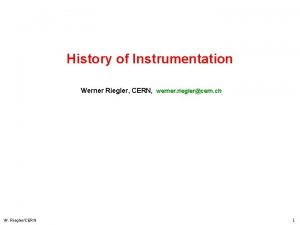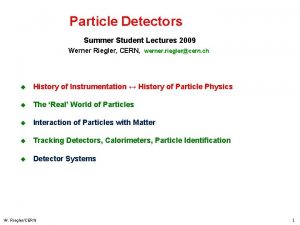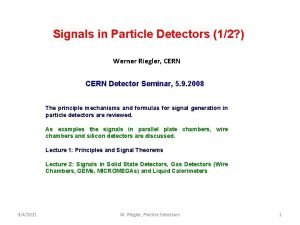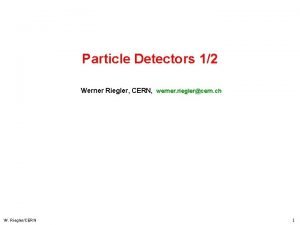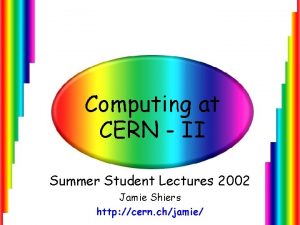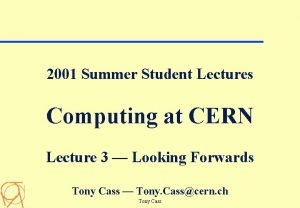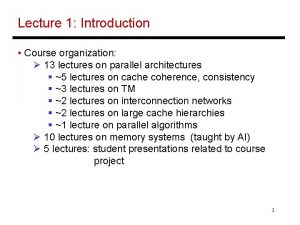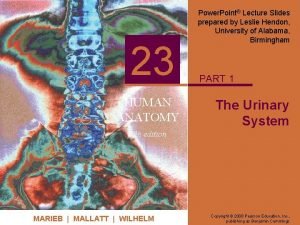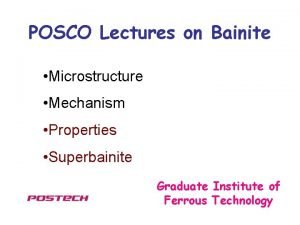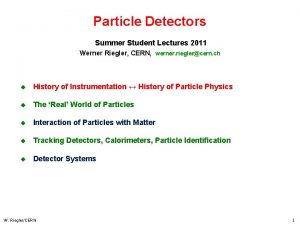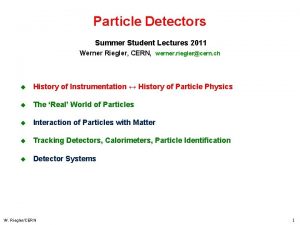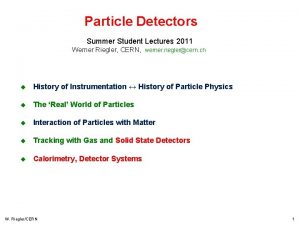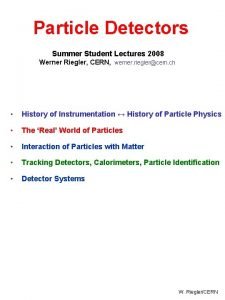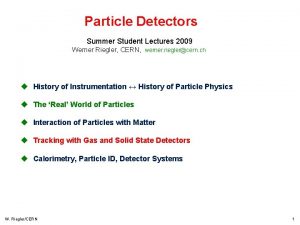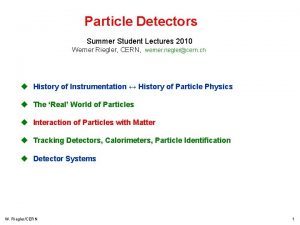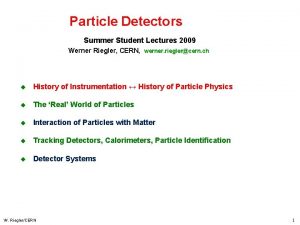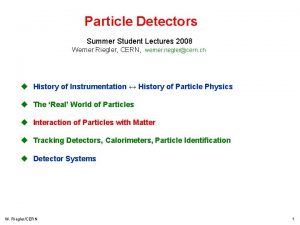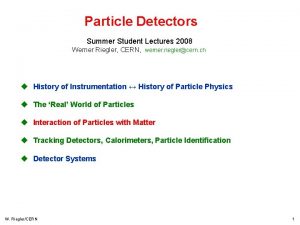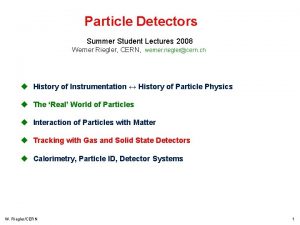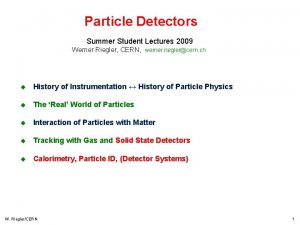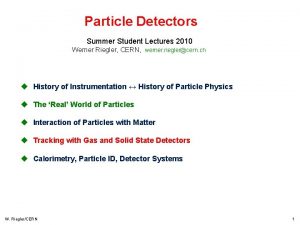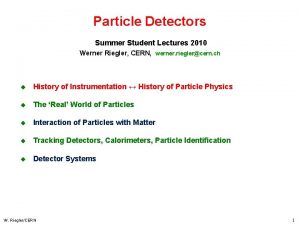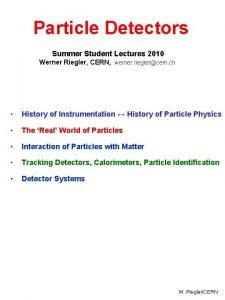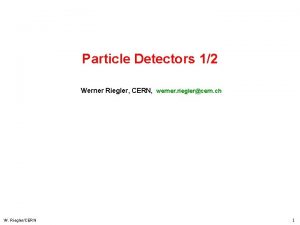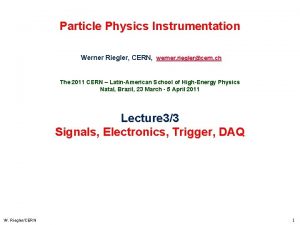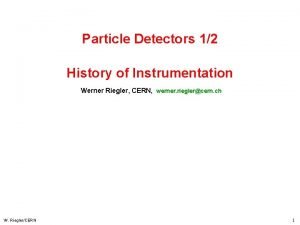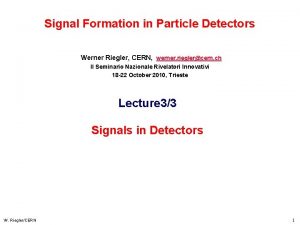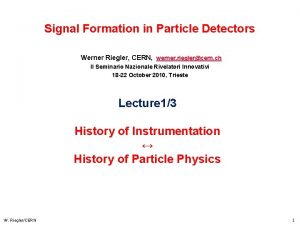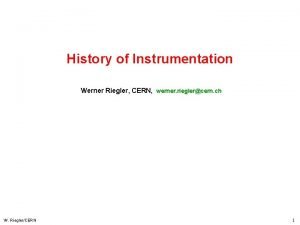Particle Detectors Summer Student Lectures 2011 Werner Riegler

















































- Slides: 49

Particle Detectors Summer Student Lectures 2011 Werner Riegler, CERN, werner. riegler@cern. ch u History of Instrumentation ↔ History of Particle Physics u The ‘Real’ World of Particles u Interaction of Particles with Matter u Tracking with Gas and Solid State Detectors u Calorimetry, Particle ID, Detector Systems W. Riegler/CERN 1

Electromagnetic Interaction of Particles with Matter Z 2 electrons, q=-e 0 M, q=Z 1 e 0 Interaction with the atomic electrons. The incoming particle loses energy and the atoms are excited or ionized. 10/28/2020 Interaction with the atomic nucleus. The particle is deflected (scattered) causing multiple scattering of the particle in the material. During this scattering a Bremsstrahlung photon can be emitted. In case the particle’s velocity is larger than the velocity of light in the medium, the resulting EM shockwave manifests itself as Cherenkov Radiation. When the particle crosses the boundary between two media, there is a probability of the order of 1% to produced and X ray photon, called Transition radiation. 2

Creation of the Signal Charged particles traversing matter leave excited atoms, electron-ion pairs (gases) or electrons-hole pairs (solids) behind. Excitation: The photons emitted by the excited atoms in transparent materials can be detected with photon detectors like photomultipliers or semiconductor photon detectors. Ionization: By applying an electric field in the detector volume, the ionization electrons and ions are moving, which induces signals on metal electrodes. These signals are then read out by appropriate readout electronics. 10/28/2020 3

Detectors based on registration of excited Atoms Scintillators W. Riegler/CERN Scintillator Detectors 4

Detectors based on Registration of excited Atoms Scintillators Emission of photons of by excited Atoms, typically UV to visible light. a) Observed in Noble Gases (even liquid !) b) Inorganic Crystals à Substances with largest light yield. Used for precision measurement of energetic Photons. Used in Nuclear Medicine. c) Polyzyclic Hydrocarbons (Naphtalen, Anthrazen, organic Scintillators) à Most important category. Large scale industrial production, mechanically and chemically quite robust. Characteristic are one or two decay times of the light emission. Typical light yield of scintillators: Energy (visible photons) few of the total energy Loss. z. B. 1 cm plastic scintillator, 1, d. E/dx=1. 5 Me. V, ~15 ke. V in photons; i. e. ~ 15 000 photons produced. W. Riegler/CERN Scintillator Detectors 5

Detectors based on Registration of excited Atoms Scintillators Organic (‘Plastic’) Scintillators Low Light Yield Fast: 1 -3 ns LHC bunchcrossing 25 ns W. Riegler/CERN Scintillator Detectors Inorganic (Crystal) Scintillators Large Light Yield Slow: few 100 ns LEP bunchcrossing 25 s 6

Scintillators Photons are being reflected towards the ends of the scintillator. A light guide brings the photons to the Photomultipliers where the photons are converted to an electrical signal. Scintillator Light Guide Photon Detector By segmentation one can arrive at spatial resolution. Because of the excellent timing properties (<1 ns) the arrival time, or time of flight, can be measured very accurately Trigger, Time of Flight. W. Riegler/CERN Scintillator Detectors 7

Typical Geometries: UV light enters the WLS material Light is transformed into longer wavelength àTotal internal reflection inside the WLS material à ‘transport’ of the light to the photo detector W. Riegler/CERN Scintillator Detectors From C. Joram 8

The frequent use of Scintillators is due to: Well established and cheap techniques to register Photons Photomultipliers and the fast response time 1 to 100 ns Semitransparent photocathode g glass Schematic of a Photomultiplier: PC • Typical Gains (as a function of the applied voltage): 108 to 1010 • • Typical efficiency for photon detection: < 20% • For very good PMs: registration of single photons possible. • Example: 10 primary Elektrons, Gain 107 108 electrons in the end in T 10 ns. I=Q/T = 108*1. 603*10 -19/10*10 -9= 1. 6 m. A. • Across a 50 Resistor U=R*I= 80 m. V. W. Riegler/CERN Scintillator Detectors e- 9

Fiber Tracking Light transport by total internal reflection Planar geometries (end cap) Circular geometries (barrel) High geometrical flexibility Fine granularity Low mass Fast response (ns) (R. C. Ruchti, Annu. Rev. Nucl. Sci. 1996, 46, 281) W. Riegler/CERN Scintillator Detectors From C. Joram 10

Fiber Tracking Readout of photons in a cost effective way is rather challenging. W. Riegler/CERN Scintillator Detectors From C. Joram 11

Detectors based on Registration of Ionization: Tracking in Gas and Solid State Detectors Charged particles leave a trail of ions (and excited atoms) along their path: Electron-Ion pairs in gases and liquids, electron hole pairs in solids. The produced charges can be registered Position measurement Tracking Detectors. Cloud Chamber: Charges create drops photography. Bubble Chamber: Charges create bubbles photography. Emulsion: Charges ‘blacked’ the film. Gas and Solid State Detectors: Moving Charges (electric fields) induce electronic signals on metallic electrons that can be read by dedicated electronics. àIn solid state detectors the charge created by the incoming particle is sufficient. àIn gas detectors (e. g. wire chamber) the charges are internally multiplied in order to provide a measurable signal. W. Riegler/CERN Tracking Detectors 12

The induced signals are readout by dedicated electronics. The noise of an amplifier determines whether the signal can be registered. Signal/Noise >>1 The noise is characterized by the ‘Equivalent Noise Charge (ENC)’ = Charge signal at the input that produced an output signal equal to the noise. ENC of very good amplifiers can be as low as 50 e -, typical numbers are ~ 1000 e-. I=2. 9 e. V 2. 5 x 106 e/h pairs/cm In order to register a signal, the registered charge must be q >> ENC i. e. typically q>>1000 e-. Gas Detector: q=80 e- /cm too small. Solid state detectors have 1000 x more density and factor 5 -10 less ionization energy. àPrimary charge is 104 -105 times larger than is gases. 1/ Gas detectors need internal amplification in order to be sensitive to single particle tracks. ßγ W. Riegler/CERN Without internal amplification they can only be used for a large number of particles that arrive at the same time (ionization chamber). 13

Principle of Signal Induction by Moving Charges The electric field of the charge must be calculated with the boundary condition that the potential φ=0 at z=0. A point charge q at a distance z 0 Above a grounded metal plate ‘induces’ a surface charge. The total induced charge on the surface is –q. Different positions of the charge result in different charge distributions. The total induced charge stays –q. q q -q For this specific geometry the method of images can be used. A point charge –q at distance –z 0 satisfies the boundary condition electric field. The resulting charge density is (x, y) = 0 Ez(x, y) (x, y)dxdy = -q -q I=0 W. Riegler/CERN 14

Principle of Signal Induction by Moving Charges If we segment the grounded metal plate and if we ground the individual strips the surface charge density doesn’t change with respect to the continuous metal plate. q V The charge induced on the individual strips is now depending on the position z 0 of the charge. If the charge is moving there are currents flowing between the strips and ground. -q The movement of the charge induces a current. -q I 1(t) W. Riegler/CERN I 2(t) I 3(t) I 4(t) 15

Signal Theorems What are the charges induced by a moving charge on electrodes that are connected with arbitrary linear impedance elements ? One first removes all the impedance elements, connects the electrodes to ground and calculates the currents induced by the moving charge on the grounded electrodes. The current induced on a grounded electrode by a charge q moving along a trajectory x(t) is calculated the following way (Ramo Theorem): One removes the charge q from the setup, puts the electrode to voltage V 0 while keeping all other electrodes grounded. This results in an electric field En(x), the Weighting Field, in the volume between the electrodes, from which the current is calculated by These currents are then placed as ideal current sources on a circuit where the electrodes are ‘shrunk’ to simple nodes and the mutual electrode capacitances are added between the nodes. These capacitances are calculated from the weighting fields by 16

More on signal theorems, readout electronics etc. can be found in this book W. Riegler/CERN 17

Signals in a Parallel Plate Geometry I 2 E. g. : or or Elektron-ion pair in gas Electron-ion pair in a liquid Electron-hole pair in a solid z Z=D E -q, ve I 1 dt = q/D*ve Te + q/D*v. I*TI = q/D*ve*(D-z 0)/ve + q/D*v. I*z 0/v. I = q(D-z 0)/D + qz 0/D = qe+q. I=q Qtot 1= Z=z 0 Z=0 I 1 E 1=V 0/D E 2=-V 0/D I 1= -(-q)/V 0*(V 0/D)*ve - q/V 0 (V 0/D) (-v. I) = q/D*ve+q/D*v. I I 2=-I 1 q, v. I I 1(t) Te TI t q Q 1(t) The total induced charge on a specific electrode, once all the charges have arrived at the electrodes, is equal to the charge that has arrived at this specific electrode. W. Riegler/CERN 18

Detectors based on Ionization Gas detectors: • Wire Chambers • Drift Chambers • Time Projection Chambers • Transport of Electrons and Ions in Gases Solid State Detectors W. Riegler/CERN • Transport of Electrons and Holes in Solids • Si- Detectors • Diamond Detectors 19

Gas Detectors with internal Electron Multiplication Principle: At sufficiently high electric fields (100 k. V/cm) the electrons gain energy in excess of the ionization energy secondary ionzation etc. d. N = N α dx α…Townsend Coefficient N(x) = N 0 exp (αx) N/ N 0 = A (Amplification, Gas Gain) Avalanche in a homogeneous field: Problem: High field on electrode surface breakdown Ions E Electrons In an inhomogeneous Field: α(E) N(x) = N 0 exp [ α(E(x’))dx’] W. Riegler/CERN 20

Wire Chamber: Electron Avalanche Wire with radius (10 -25 m) in a tube of radius b (1 -3 cm): Electric field close to a thin wire (100 -300 k. V/cm). E. g. V 0=1000 V, a=10 m, b=10 mm, E(a)=150 k. V/cm Electric field is sufficient to accelerate electrons to energies which are sufficient to produce secondary ionization electron avalanche signal. ab W. Riegler/CERN b Wire 21

Wire Chamber: Electron Avalanches on the Wire Proportional region: A 103 -104 LHC Semi proportional region: A 104 -105 (space charge effect) Saturation region: A >106 Independent the number of primary electrons. 1970 ies Streamer region: A >107 Avalanche along the particle track. Limited Geiger region: Avalanche propagated by UV photons. Geiger region: A 109 Avalanche along the entire wire. W. Riegler/CERN 1950 ies 22

Wire Chamber: Signals from Electron Avalanches The electron avalanche happens very close to the wire. First multiplication only around R =2 x wire radius. Electrons are moving to the wire surface very quickly (<<1 ns). Ions are difting towards the tube wall (typically several 100 s. ) The signal is characterized by a very fast ‘spike’ from the electrons and a long Ion tail. The total charge induced by the electrons, i. e. the charge of the current spike due to the short electron movement amounts to 1 -2% of the total induced charge. W. Riegler/CERN 23

Detectors with Electron Multiplication Rossi 1930: Coincidence circuit for n tubes Cosmic ray telescope 1934 Geiger mode, large deadtime Position resolution is determined by the size of the tubes. Signal was directly fed into an electronic tube. W. Riegler/CERN 24

Multi Wire Proportional Chamber Classic geometry (Crossection), Charpak 1968 : One plane of thin sense wires is placed between two parallel plates. Typical dimensions: Wire distance 2 -5 mm, distance between cathode planes ~10 mm. Electrons (v 5 cm/ s) are collected within 100 ns. The ion tail can be eliminated by electronics filters pulses of <100 ns length. For 10% occupancy every s one pulse 1 MHz/wire rate capabiliy ! Compare to Bubble Chamber with 10 Hz ! W. Riegler/CERN 25

Multi Wire Proportional Chamber In order to eliminate the left/right ambiguities: Shift two wire chambers by half the wire pitch. For second coordinate: àAnother chamber at 900 relative rotation àSignal propagation to the two ends of the wire. àPulse height measurement on both ends of the wire. Because of resisitvity of the wire, both ends see different charge. Segmenting of the cathode into strips or pads: The movement of the charges induces a signal on the wire AND on the cathode. By segmentation of the cathode plane and charge interpolation, resolutions of 50 m can be achieved. W. Riegler/CERN 26

Multi Wire Proportional Chamber Cathode strip: Width (1 ) of the charge distribution distance between Wires and cathode plane. ‘Center of gravity’ defines the particle trajectory. Avalanche W. Riegler/CERN 27

Drift Chambers Amplifier: t=T E Scintillator: t=0 In an alternating sequence of wires with different potentials one finds an electric field between the ‘sense wires’ and ‘field wires’. The electrons are moving to the sense wires and produce an avalanche which induces a signal that is read out by electronics. The time between the passage of the particle and the arrival of the electrons at the wire is measured. The drift time T is a measure of the position of the particle ! By measuring the drift time, the wire distance can be increased (compared to the Multi Wire Proportional Chamber) save electronics channels ! W. Riegler/CERN 28

Drift Chambers, typical Geometries Electric Field 1 k. V/cm U. Becker Instr. of HEP, Vol#9, p 516 World Scientific (1992) ed F. Sauli W. Riegler/CERN 29

The Geiger Counter reloaded: Drift Tube Primary electrons are drifting to the wire. ATLAS MDT R(tube) =15 mm Calibrated Radius-Time correlation Electron avalanche at the wire. The measured drift time is converted to a radius by a (calibrated) radius-time correlation. Many of these circles define the particle track. ATLAS Muon Chambers ATLAS MDTs, 80 m per tube W. Riegler/CERN 30

The Geiger counter reloaded: Drift Tube Atlas Muon Spectrometer, 44 m long, from r=5 to 11 m. 1200 Chambers 6 layers of 3 cm tubes per chamber. Length of the chambers 1 -6 m ! Position resolution: 80 m/tube, <50 m/chamber (3 bar) Maximum drift time 700 ns Gas Ar/CO 2 93/7 W. Riegler/CERN 31

Large Drift Chambers Central Tracking Chamber CDF Experiment. 660 drift cells tilted 450 with respect to the particle track. Drift cell W. Riegler/CERN 32

Transport of Electrons in Gases: Drift-velocity Ramsauer Effect Electrons are completely ‘randomized’ in each collision. The actual drift velocity v along the electric field is quite different from the average velocity u of the electrons i. e. àabout 100 times smaller. The velocities v and u are determined by the atomic crossection ( ) and the fractional energy loss ( ) per collision (N is the gas density i. e. number of gas atoms/m 3, m is the electron mass. ): Because ( )und ( ) show a strong dependence on the electron energy in the typical electric fields, the electron drift velocity v shows a strong and complex variation with the applied electric field. v is depending on E/N: doubling the electric field and doubling the gas pressure at the same time results in the same electric field. W. Riegler/CERN 33

Transport of Electrons in Gases: Drift-velocity Typical Drift velocities are v=5 -10 cm/ s (50 000 -100 000 m/s). The microscopic velocity u is about ca. 100 mal larger. Only gases with very small electro negativity are useful (electron attachment) àNoble Gases (Ar/Ne) are most of the time the main component of the gas. àAdmixture of CO 2, CH 4, Isobutane etc. for ‘quenching’ is necessary (avalanche multiplication – see later). W. Riegler/CERN 34

Transport of Electrons in Gases: Diffusion An initially point like cloud of electrons will ‘diffuse’ because of multiple collisions and assume a Gaussian shape. The diffusion depends on the average energy of the electrons. The variance σ2 of the distribution grows linearly with time. In case of an applied electric field it grows linearly with the distance. Electric Field x Solution of the diffusion equation (l=drift distance) Thermodynamic limit: Because = (E/P) W. Riegler/CERN 35

Transport of Electrons in Gases: Diffusion The electron diffusion depends on E/P and scales in addition with 1/ P. At 1 k. V/cm and 1 Atm Pressure thermodynamic limit is =70 m for 1 cm Drift. ‘Cold’ gases are close to thermodynamic limit i. e. gases where the average microscopic energy =1/2 mu 2 is close to thermal energy 3/2 k. T. CH 4 has very large fractional energy loss low diffusion. Argon has small fractional energy loss/collision large diffusion. W. Riegler/CERN 36

Drift of Ions in Gases Because of the larger mass of the Ions compared to electrons they are not randomized in each collision. The crossections are constant in the energy range of interest. Below thermal energy the velocity is proportional to the electric field v = μE (typical). Ion mobility μ 1 -10 cm 2/Vs. Above thermal energy the velocity increases with E. V= E, (Ar)=1. 5 cm 2/Vs 1000 V/cm v=1500 cm/s=15 m/s 3000 -6000 times slower than electrons ! W. Riegler/CERN 37

Time Projection Chamber (TPC): Gas volume with parallel E and B Field. B for momentum measurement. Positive effect: Diffusion is strongly reduced by E//B (up to a factor 5). Drift Fields 100 -400 V/cm. Drift times 10 -100 s. Distance up to 2. 5 m ! gas volume B drift E y x z charged track Wire Chamber to detect the tracks W. Riegler/CERN 38

STAR TPC (BNL) Event display of a Au Au collision at CM energy of 130 Ge. V/n. Typically around 200 tracks per event. Great advantage of a TPC: The only material that is in the way of the particles is gas very low multiple scattering very good momentum resolution down to low momenta ! 10/28/2020 W. Riegler, Particle 39

ALICE TPC: Detector Parameters • • Gas Ne/ CO 2 90/10% Field 400 V/cm Gas gain >104 Position resolution = 0. 25 mm Diffusion: t= 250 m Pads inside: 4 x 7. 5 mm Pads outside: 6 x 15 mm B-field: 0. 5 T W. Riegler/CERN 40

ALICE TPC: Construction Parameters • Largest TPC: – Length 5 m – Diameter 5 m – Volume 88 m 3 – Detector area 32 m 2 – Channels ~570 000 • High Voltage: – Cathode -100 k. V • Material X 0 – Cylinder from composite materials from airplane industry (X 0= ~3%) W. Riegler/CERN 41

ALICE TPC: Pictures of the Construction Precision in z: 250 m W. Riegler/CERN End plates 250 m Wire chamber: 40 m 42

ALICE TPC Construction My personal contribution: A visit inside the TPC. W. Riegler/CERN 43

TPC installed in the ALICE Experiment 10/28/2020 W. Riegler, CERN

First 7 Te. V p-p Collisions in the ALICE TPC in March 2010 ! 10/28/2020

First Pb Pb Collisions in the ALICE TPC in Nov 2010 ! 10/28/2020

GEMs & MICROMEGAS Narrow gap (50 -100 µm) PPC with thin cathode mesh Insulating gap-restoring wires or pillars Y. Giomataris et al, Nucl. Instr. and Meth. A 376(1996)239 10/28/2020 W. Riegler, Particle GEM Thin metal-coated polymer foils 70 µm holes at 140 mm pitch F. Sauli, Nucl. Instr. and Methods A 386(1997)531 47

MPGDs with Integrate Micromesh, INGRID Going even another step further, by wafer post-processing techniques, MPGD structure scan be put on top of a pixelized readout chip, making the entire detector a monolithic unit ! Integrated. Grid (INGRID). In addition a TDC was put on each pixel measuring drift times Micromesh on a pixelized readout chip produced by Opto-Chemical Wafer Post-Processing Techniques. With 3 cm Drift gap: 5 cm 3 Mini TPC ! Tracks from Sr 90 source in 0. 2 T Magnetic Field ! Single ionization electrons are seen. Fantastic position resolution … 10/28/2020 W. Riegler, Particle 48

Summary on Gas Detectors Wire chambers feature prominently at LHC. A decade of very extensive studies on gases and construction materials has lead to wire chambers that can track up to MHz/cm 2 of particles, accumulate up to 1 -2 C/cm of wire and 1 -2 C/cm 2 of cathode area. While silicon trackers currently outperform wire chambers close to the interaction regions, wire chambers are perfectly suited for the large detector areas at outer radii. Large scale next generation experiments foresee wire chambers as large area tracking devices. The Time Projection Chamber – if the rate allows it’s use – is unbeatable in terms of low material budget and channel economy. There is no reason for replacing a TPC with a silicon tracker. Gas detectors can be simulated very accurately due to excellent simulation programs. Novel gas detectors, the Micro Pattern Gas Detectors, have proven to work efficiently as high rate, low material budget trackers in the ‘regime’ between silicon trackers and large wire chambers. 10/28/2020 W. Riegler, Particle 49
 Werner riegler cern
Werner riegler cern Werner riegler
Werner riegler Werner riegler cern
Werner riegler cern Werner riegler
Werner riegler Cern summer student lectures
Cern summer student lectures Cern summer school lectures
Cern summer school lectures Medical emergency student lectures
Medical emergency student lectures Hematology medicine student lectures
Hematology medicine student lectures Harald riegler
Harald riegler Chromatography mobile phase and stationary phase
Chromatography mobile phase and stationary phase Feature detectors
Feature detectors Vhv voltage detectors
Vhv voltage detectors Where are feature detectors located
Where are feature detectors located Giant wave detectors murmurs universe
Giant wave detectors murmurs universe Frontier detectors for frontier physics
Frontier detectors for frontier physics Photo detectors
Photo detectors Kinesthesis and vestibular sense
Kinesthesis and vestibular sense Wave could hear murmurs across universe
Wave could hear murmurs across universe Photo detectors
Photo detectors Diagnosing error in object detectors
Diagnosing error in object detectors Nuclear detectors
Nuclear detectors Feature vectors
Feature vectors Streaming current detectors
Streaming current detectors Molecular biology lectures
Molecular biology lectures Ota resident lectures
Ota resident lectures Uva presentation template
Uva presentation template Stratog online lectures
Stratog online lectures 13 lectures
13 lectures Oral communication 3 lectures text
Oral communication 3 lectures text Theory of translation lectures
Theory of translation lectures Web engineering lectures ppt
Web engineering lectures ppt Neonatology lectures
Neonatology lectures Hugh blair lectures on rhetoric
Hugh blair lectures on rhetoric Slagle lecture
Slagle lecture Nuclear medicine lectures
Nuclear medicine lectures Introduction to recursion
Introduction to recursion Radio astronomy lectures
Radio astronomy lectures Anatomy lectures powerpoint
Anatomy lectures powerpoint Cs614 short lectures
Cs614 short lectures Reinforcement learning lectures
Reinforcement learning lectures Bhadeshia lectures
Bhadeshia lectures C programming and numerical analysis an introduction
C programming and numerical analysis an introduction Digital logic design lectures
Digital logic design lectures Power system lectures
Power system lectures How to get the most out of lectures
How to get the most out of lectures Pathology lectures for medical students
Pathology lectures for medical students Data mining lectures
Data mining lectures Theory of translation lectures
Theory of translation lectures Gpoint c++
Gpoint c++ Guyton physiology lectures
Guyton physiology lectures
